A Call to Action!
Creating Effective Professional Learning for Teacher and Student Success
*For a better experience, view in full-screen mode.*

How to Create Effective Professional Learning for Educators: A Quick Five-Step Guide
Professional learning is an essential part of any educator’s career, as it helps them develop new knowledge, skills, and strategies to improve their teaching practice and student outcomes. However, not all professional learning is created equal. Some professional learning activities are more effective than others in changing teachers’ behavior and impacting student achievement. How can you create or reinvent professional learning that works for educators?
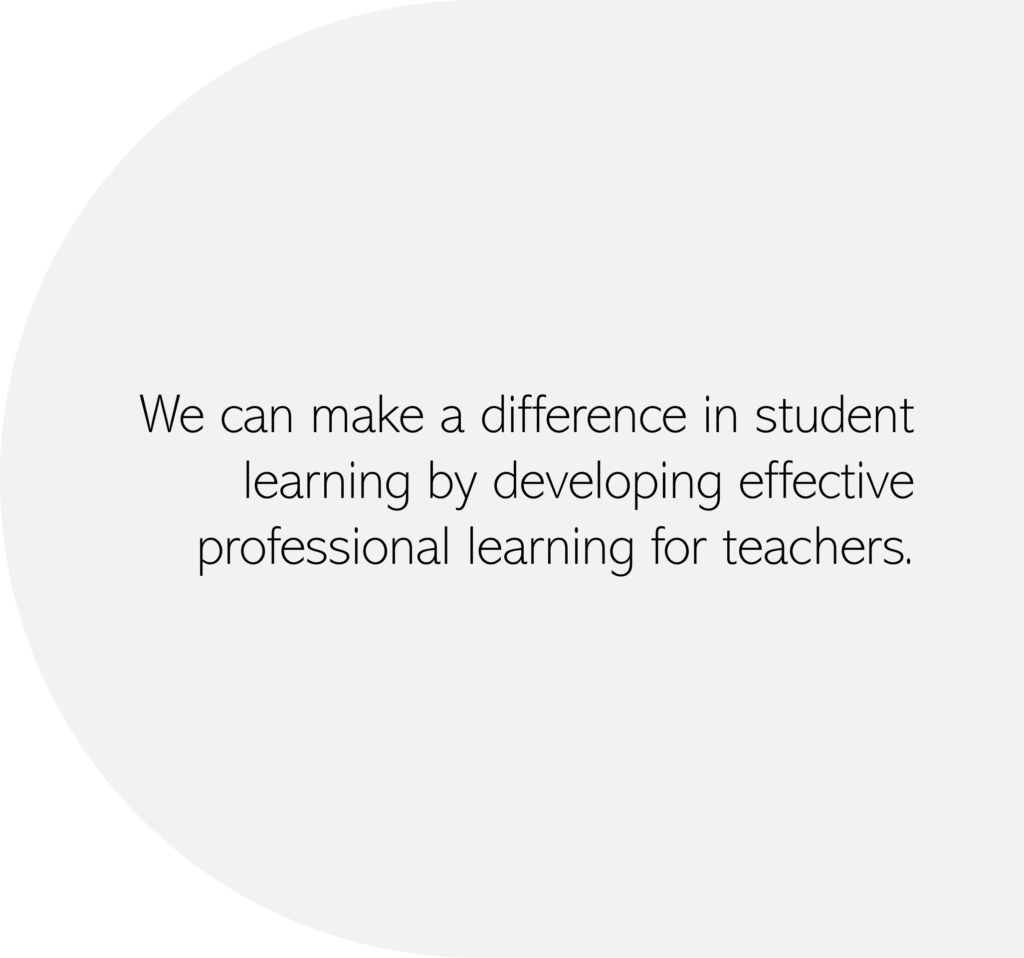
Here are five steps to follow, grounded in the research-based principles from “Effective Professional Development in an Era of High Stakes Accountability” by Allison Gulamhussein for the Center of Public Education:
Duration

The duration of professional development must be significant and ongoing to allow time for teachers to learn a new strategy and grapple with the implementation problem.
Research shows that short-term or one-time workshops are not effective in changing teachers’ practice or improving student outcomes. A comprehensive study examined the whole range of research on professional development and found that only long and intensive programs improved student achievement (Yoon et al., 2007). Shorter programs that lasted less than 14 hours, such as the typical workshops offered in schools, had no impact on student learning or teaching practices. Another study published in the Association for Supervision and Curriculum Development found that teachers need an average of 20 separate instances of practice to master a new skill in the classroom and that number may increase if the skill is exceptionally complex (Joyce & Showers, 2002).
In short, effective professional learning on a concept should not be a one-time thing but instead should span over several weeks or months, and include at least 14 hours of contact time.
Support

There must be support for a teacher during the implementation stage that addresses the specific challenges of changing classroom practice.
Research shows that teachers are more likely to change their teaching practices and improve student outcomes when they receive support during this stage from experts or peers who can offer coaching, feedback, collaboration, and guidance (Gulamhussein, 2013). Support should be tailored to the individual needs and goals of each teacher and should be provided by peers or experts who have experience and expertise in the new strategy or practice.
Doing this will help teachers overcome the challenges and frustrations that might arise from trying out a new instructional method in their classrooms.
Active Participation

Teachers’ initial exposure to a concept should not be passive, but rather should engage teachers through varied approaches so they can participate actively in making sense of a new practice.
Research shows that passive methods, such as lectures or presentations, are not effective in changing teachers’ practice or improving student outcomes. Instead, professional learning should use active methods, such as discussions, simulations, demonstrations, case studies, or experiments, that allow teachers to interact with the content, ask questions, reflect on their own practice, and construct their own understanding.
Active methods of professional learning are more effective than passive methods because they engage teachers in deeper and more meaningful learning. According to the adult learning theory, adults learn best when they are actively involved in the learning process, and when they can connect the new knowledge or skill to their prior experience and current practice (Knowles et al., 2005). Active methods of professional learning allow teachers to do this, by enabling them to interact with the content, ask questions, reflect on their own practice, and construct their own understanding.
Modeling

Modeling has been found to be highly effective in helping teachers understand a new practice.
Modeling helps teachers visualize how a new strategy or practice works in action and provides them with a concrete example to follow and imitate. Modeling can be done by experts or peers who demonstrate the new concept or practice in a real or simulated classroom setting and explain the rationale and steps behind it. Modeling should also include opportunities for teachers to observe, analyze, and critique the model, and to practice the new concept themselves with authentic and constructive feedback and guidance from the peer, model, or coach.
By providing teachers with the opportunity to experience modeling firsthand, they are in turn better equipped to implement new strategies and practices in their own classrooms.
Relevant

The content presented to teachers shouldn’t be generic, but instead specific to the discipline (for middle school and high school teachers) or grade-level (for elementary school teachers).
Research shows that teachers are more likely to adopt a new strategy or practice if it is relevant to their curriculum, standards, assessments, and students’ needs. Professional learning should use examples, materials, and scenarios that are specific to the teacher’s grade-level and content area, and that address the challenges and opportunities that they face in their own context.
This way, professional learning can be more meaningful and engaging for teachers because they can directly see how a new strategy or practice relates to their own teaching goals and situations. It can also be more effective and transferable, as teachers can learn how to adapt the new strategy or practice to their own students’ needs and abilities. Furthermore, it can encourage collaboration because in professional learning sessions that are relevant to content areas or grade levels, teachers can share their experiences and feedback with their peers who teach in the same area.
By following these five steps, we can create effective professional learning for educators that can change their teaching practice and improve our students’ outcomes. Remember that professional learning is not a one-time event, but a continuous process that requires ongoing planning, implementation, evaluation, and improvement. Click here and here to see how professional learning sessions that follow these steps look.
The Backstory
My journey toward implementing and now advocating for a more impactful style of professional learning began with a realization that struck me during my early years as a teacher. I witnessed countless instances where my colleagues and I would attend one-stop professional development workshops and have one of three typical outcomes.
If the training was highly engaging and relevant to our practice, we would either:
- Enthusiastically acquire new knowledge, regroup in our grade-level or content area planning teams, and collaborate to come up with a plan of implementation. While we were held accountable for implementing our learning, we were also supported by our trainer(s) or campus administrators, and it almost always involved us (the teachers) customizing our implementation in ways that would best support our students’ needs, or
- Eagerly absorb the new information and return to our classrooms brimming with enthusiasm to implement what we had learned. However, with little to no follow-up or accountability, the days would turn into weeks, and the weeks into months, and the initial excitement would gradually fade, and the newly acquired knowledge would often be relegated to a dusty filing cabinet and forgotten.
Regardless of whether the training was engaging or not, if the professional development session was deemed irrelevant to our practice, we would:
- Head back to our classrooms or call each other on our drive home and vent about why in the world we were made to sit through an hours long PD session which was highly irrelevant and unrelated to our practice. After all, we could’ve used the time spent for something more productive like planning, grading, keeping in touch with parents, etc.

Learning About Learning
When I moved on to becoming a Learning and Development Specialist, the disheartening pattern of outcomes mentioned in points two and three above sparked a deep desire within me to understand why so much professional learning seemed to have a limited impact on classroom practice. I also made a mental note that I would do my best to create professional learning sessions that were not only meaningful and relevant to the educators and campuses I support, but also led to verifiable improvements in teachers’ practice and student outcomes. While I did not engage in formal learning on the topic, I looked up (via YouTube and Google searches) information about adult learning and best practices for professional learning.
At the time, I learned about Andragogy (or Adult Learning Theory), a term popularized by the late American educator Malcom Knowles that details five assumptions of adult learners:
- Self-concept: Adults engage in more self-directed and independent learning as we mature.
- Learner experience: Adults bring background knowledge and experience to the learning process.
- Readiness to learn: Adults are interested in learning things that enable them to perform relevant tasks.
- Orientation to learning: Adults shift from subject-based learning, which emphasizes theoretical knowledge of a concept, to problem-based learning, which targets practical knowledge that aids in problem solving.
- Motivation to learn: Adults draw motivation from intrinsic and internal rather than external sources.
I also learned about the ADDIE model of instructional design. The ADDIE model is a widely used framework for designing and developing effective instructional materials and professional learning. It consists of five phases that guide the process of developing learning content and instructional design:
- Analysis: The instructional problem is clarified, the instructional goals and objectives are established, and the learning environment and learner’s existing knowledge and skills are identified.
- Design: Learning objectives, assessment instruments, exercises, content, subject matter analysis, lesson planning, and media selection are determined.
- Development: Developers create and assemble the content assets that were created in the design phase. This may include creating storyboards, designing the user interface and user experience, applying visual design, and developing prototypes.
- Implementation: Instructional materials are delivered or distributed to the learners. This may involve conducting training sessions, installing software, distributing online courses, or providing support and guidance to the learners.
- Evaluation: The effectiveness of the instructional materials is assessed. This may involve collecting feedback from the learners, measuring learning outcomes, conducting usability tests, or analyzing data and evidence.
By using the principles of Adult Learning Theory and the ADDIE model, I was able to better ensure that the learning objectives in the professional learning sessions I put together were aligned with the teachers’ needs, the instructional strategies were appropriate and engaging, the learning materials were of high quality, the learning outcomes were measured and evaluated, and the feedback provided by teachers/participants was used for continuous improvement. However, I knew there was still room for improving the retention of knowledge and skills over time and the transfer of learning to application and practice (leading to improved outcomes for students).
This leads me to the present day… as a current graduate student, I’ve now had the opportunity to learn even more about the research conducted into professional learning for educators. Specifically, I’ve had the opportunity to read:
– The Mirage: Confronting the Hard Truth About Our Quest for Teacher Development which is a report released by TNTP (formerly known as The New Teacher Project) that reveals the enormous investment school systems are making in teacher improvement and challenged the perceptions school leaders have about what is takes to improve the quality of classroom teaching.
– Effective Professional Development in an Era of High Stakes Accountability, a detailed paper by Allison Gulamhussein that provides a research-based answer to how districts can structure professional development so that teachers change their teaching practices and increase student learning.
– A Quick Reference Guide: Standards for Professional Learning, an abbreviated guide that provides the seven standards for professional learning and four prerequisites that must exist for professional learning to take place.
Each of these texts provides research and evidence-based practices and recommendations that can help improve learning application and outcomes for educators and in turn, improve learning outcomes for students.
🎬 Creating a Call to Action
Through my own experiences as an educator and a learner, I realized the limitations and challenges of traditional professional learning that often fails to change teachers’ practice and improve student outcomes. I also learned from reading the research on effective professional learning that there are better ways to design and deliver professional learning that are more aligned with the needs and preferences of adult learners, the principles of instructional design, and the goals of teaching and learning. This led me to the firm belief that we need a more impactful style of professional learning that can help teachers develop the knowledge, skills, and confidence they need to make lasting changes in their classrooms and enhance their students’ learning.
A Peek Behind the Scenes

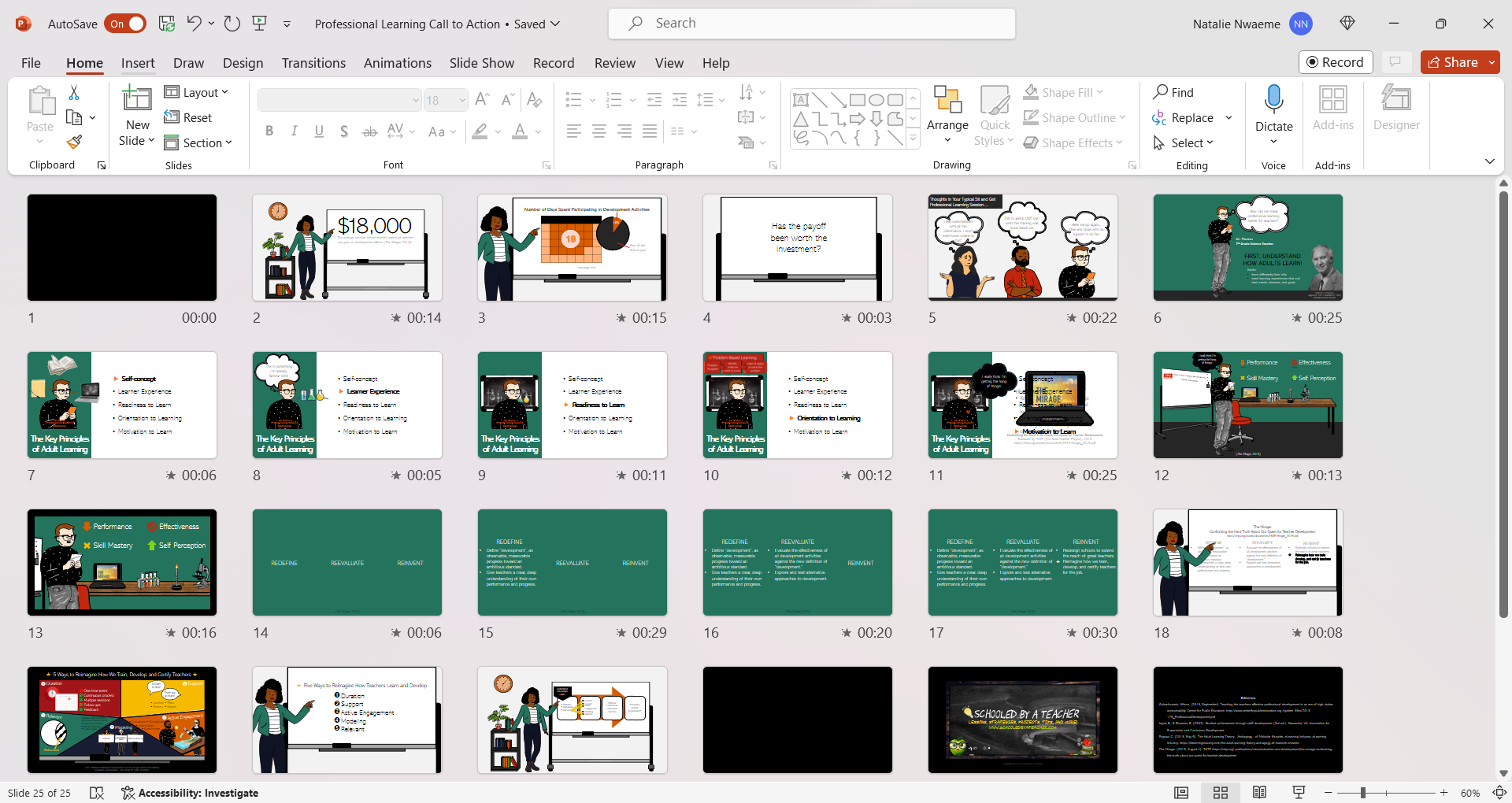
I created my Alternate Professional Learning call to action in Microsoft PowerPoint and then subsequently rendered the presentation as a video, using the built-in video recording capabilities of the software. In doing so, I was able to capture the essence of my message in a visually appealing and engaging format that could be easily shared with a wider audience as a slide deck or as a video.

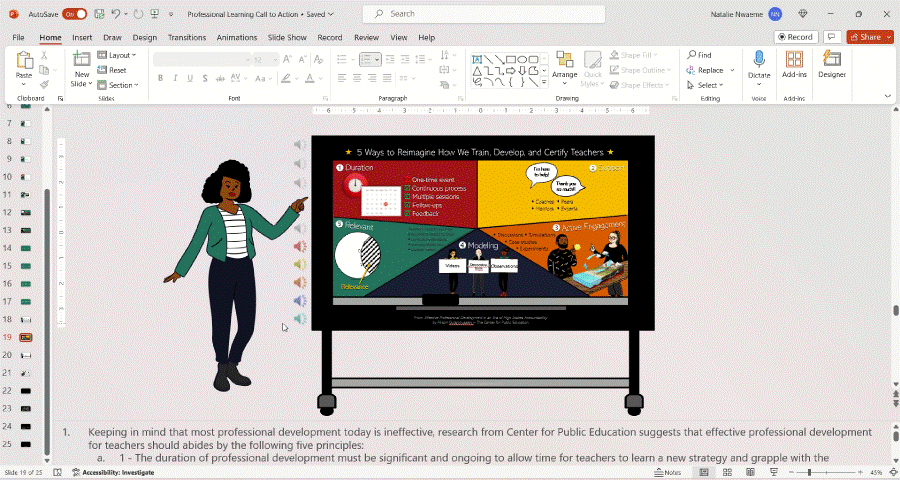
Using the various tools features found in Microsoft PowerPoint allowed me to add additional elements to my presentation, such as voiceover narration, on-screen text, and transitions, which further enhanced the overall impact of my message. Additionally, the video format is readily accessible and can be embedded and/or viewed using a variety of platforms like YouTube and Vimeo.
I used a consistent color palette throughout the entire presentation to create a harmonious and professional look and to enhance the readability and clarity of the slides. The graphics were also consistent in style, and I used a mixture of layered shapes, graphics, and fonts to build each character and scene element.
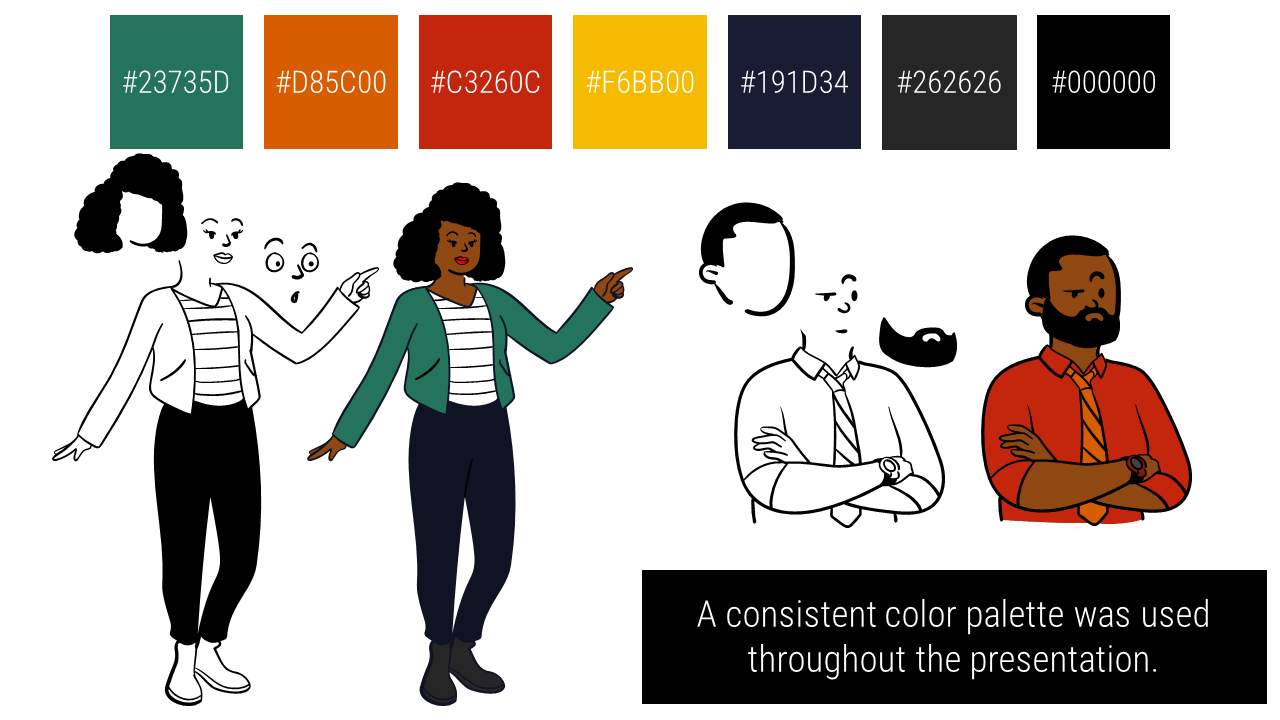
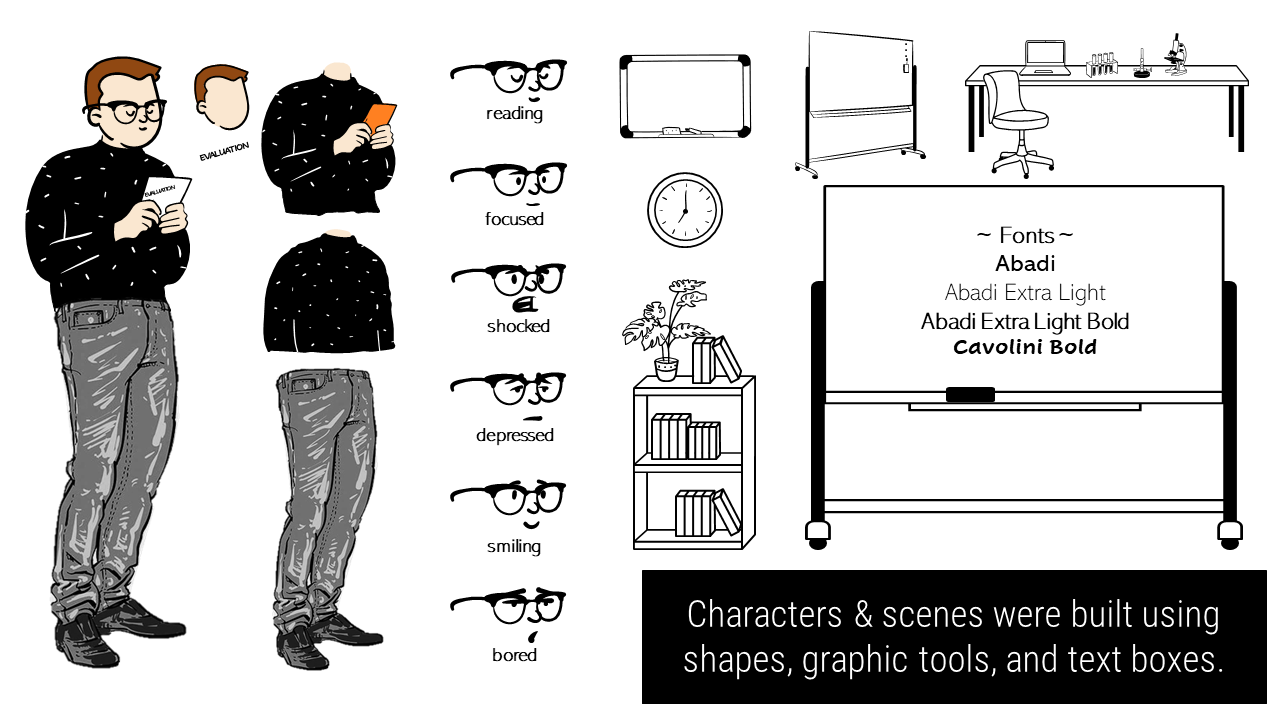
In order to ensure that my presentation/video followed a logical order, I put together a concise outline that summarizes the main points and subpoints of my message, organizes them into a coherent and clear structure, and guides the flow and transitions of my content.